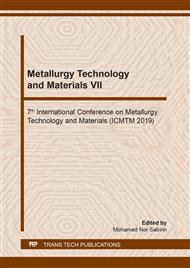[1]
T.V. Tran, D.T.C. Nguyen, H.T.N. Le, C.D. Duong, L.G. Bach, H.T.T. Nguyen, T.D. Nguyen, Facile synthesis of manganese oxide-embedded mesoporous carbons and their adsorbability towards methylene blue, Chemosphere 227 (2019) 455-461.
DOI: 10.1016/j.chemosphere.2019.04.079
Google Scholar
[2]
L.T.T. Nguyen, L.T.H. Nguyen, A.T.T. Duong, B.D. Nguyen, N.Q. Hai, V.H. Chu, T.D. Nguyen, L.G. Bach, Preparation, Characterization and Photocatalytic Activity of La-Doped Zinc Oxide Nanoparticles, Materials 12 (2019), 1195;.
DOI: 10.3390/ma12081195
Google Scholar
[3]
T.V. Tran, D.T.C. Nguyen, H.T.N. Le, L.G. Bach, D.V.N. Vo, K.T. Lim, L.X. Nong, T.D. Nguyen, Combined Minimum-Run Resolution IV and Central Composite Design for Optimized Removal of Tetracycline Drug Over Metal–Organic Framework-5 Templated Porous Carbon, Molecules 24 (2019) 1887.
DOI: 10.3390/molecules24101887
Google Scholar
[4]
K. H. Goh, T. T. Lim, Z. Dong, Application of layered double hydroxides for removal of oxyanions: A review, Water Res., 42 (2008) 1343-1368.
DOI: 10.1016/j.watres.2007.10.043
Google Scholar
[5]
M. Sarfraz and I. Shakir, Recent advances in layered double hydroxides as electrode materials for high-performance electrochemical energy storage devices, J. Energy Storage, 13 (2017) 103-122.
DOI: 10.1016/j.est.2017.06.011
Google Scholar
[6]
C. Forano, U. Costantino, V. Prévot, and C. T. Gueho, Layered double hydroxides (LDH), Dev. Clay Sci., 5 (2013) 745-782.
DOI: 10.1016/b978-0-08-098258-8.00025-0
Google Scholar
[7]
B. Zhang, Z. Dong, D. Sun, T. Wu, and Y. Li, Enhanced adsorption capacity of dyes by surfactant-modified layered double hydroxides from aqueous solution, J. Ind. Eng. Chem., 49 (2017) 208-218.
DOI: 10.1016/j.jiec.2017.01.029
Google Scholar
[8]
N. Baig and M. Sajid, Applications of layered double hydroxides based electrochemical sensors for determination of environmental pollutants: A review, Trends Environ. Anal. Chem., 16 (2017) 1-15.
DOI: 10.1016/j.teac.2017.10.003
Google Scholar
[9]
J. Ooi, L.Y. Lee, B.Y.Z. Hiew, S. Thangalazhy-Gopakumar, S.S. Lim, S. Gan, Assessment of fish scales waste as a low cost and eco-friendly adsorbent for removal of an azo dye: Equilibrium, kinetic and thermodynamic studies, Bioresour. Technol., 245 (2017) 656-664.
DOI: 10.1016/j.biortech.2017.08.153
Google Scholar
[10]
T. Van Thuan, B. Thi, P. Quynh, T. Duy, and V. T. Thanh, Response surface methodology approach for optimization of Cu2+, Ni2+ and Pb2+ adsorption using KOH-activated carbon from banana peel, Surfaces and Interfaces, 6 (2017) 2019-217.
DOI: 10.1016/j.surfin.2016.10.007
Google Scholar
[11]
V.T. Pham, H.T.T. Nguyen, D.T.C. Nguyen, H.T. N. Le, T.T. Nguyen, N.T.H. Le, K.T. Lim, T.D. Nguyen, T.V. Tran and L.G. Bach, Process Optimization by a Response Surface Methodology for Adsorption of Congo Red Dye onto Exfoliated Graphite-Decorated MnFe2O4 Nanocomposite: The Pivotal Role of Surface Chemistry, Processes 7 (2019) 305;.
DOI: 10.3390/pr7050305
Google Scholar
[12]
T. Van Tran, Q. T. P. Bui, T. D. Nguyen, V. T. Thanh Ho, and L. G. Bach, "Application of response surface methodology to optimize the fabrication of ZnCl2-activated carbon from sugarcane bagasse for the removal of Cu2+, Water Sci. Technol., 75 (2017) 2047-2055.
DOI: 10.2166/wst.2017.066
Google Scholar
[13]
A.I.R. Ch, Congo Red Dye Removal using Hydrilla Verticillata Powder and Optimization through Box Behnken Design, Int. J. Res. Appl. Sci. Eng. Technol., 6 (2018) 1506-1521.
DOI: 10.22214/ijraset.2018.3233
Google Scholar
[14]
L. Zhong, A. Tang, P. Yan, J. Wang, Q. Wang, X. Wen, Y. Cui, Palygorskite-template amorphous carbon nanotubes as a superior adsorbent for removal of dyes from aqueous solutions," J. Colloid Interface Sci., 537 (2019) 450-457.
DOI: 10.1016/j.jcis.2018.11.016
Google Scholar


